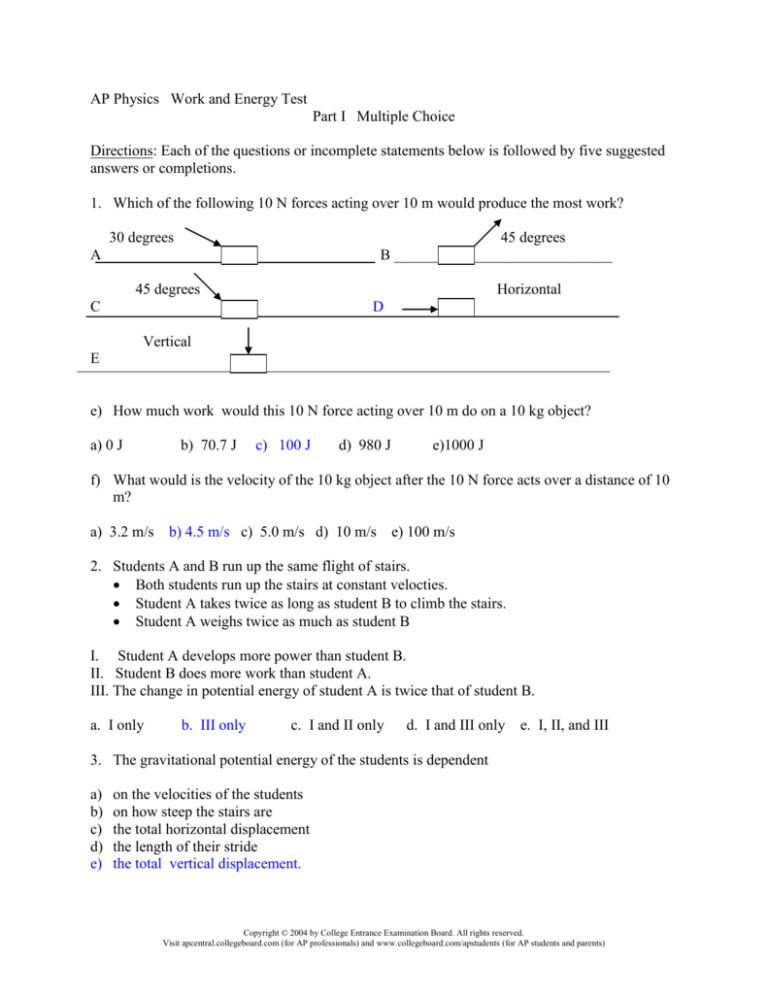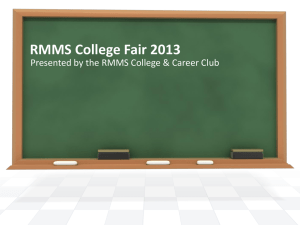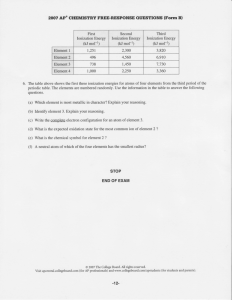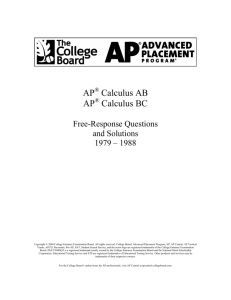
AP Physics Work and Energy Test
Part I Multiple Choice
Directions: Each of the questions or incomplete statements below is followed by five suggested
answers or completions.
1. Which of the following 10 N forces acting over 10 m would produce the most work?
30 degrees
45 degrees
B _____________________________
A
45 degrees
Horizontal
C
D
Vertical
E
e) How much work would this 10 N force acting over 10 m do on a 10 kg object?
a) 0 J
b) 70.7 J
c) 100 J
d) 980 J
e)1000 J
f) What would is the velocity of the 10 kg object after the 10 N force acts over a distance of 10
m?
a) 3.2 m/s
b) 4.5 m/s c) 5.0 m/s d) 10 m/s
e) 100 m/s
2. Students A and B run up the same flight of stairs.
Both students run up the stairs at constant velocties.
Student A takes twice as long as student B to climb the stairs.
Student A weighs twice as much as student B
I. Student A develops more power than student B.
II. Student B does more work than student A.
III. The change in potential energy of student A is twice that of student B.
a. I only
b. III only
c. I and II only
d. I and III only
e. I, II, and III
3. The gravitational potential energy of the students is dependent
a)
b)
c)
d)
e)
on the velocities of the students
on how steep the stairs are
the total horizontal displacement
the length of their stride
the total vertical displacement.
Copyright © 2004 by College Entrance Examination Board. All rights reserved.
Visit apcentral.collegeboard.com (for AP professionals) and www.collegeboard.com/apstudents (for AP students and parents)
4. When an object is dropped from a given height, h, which of the following is true of
the values of its kinetic and potential energies at 1/2 h.
Kinetic
Potential
a. Zero
Maximum
b. Zero
Zero
c. 1/2 maximum
1/2 maximum
d. Maximum
1/2 maximum
e. Maximum
Zero
5
A mass is held in place so the spring has no tension in it. The mass is then let go and
begins to move up and down. Which of the followin g graphs best decribes how the
total energy of the system changes with its motion up and down. Do not ignore air
resistance
a)
b)
Total
Energy
Total
Energy
time
Time
Total
Energy
Total
Energy
time
Time
Total
Energy
Copyright © 2004 by College Entrance Examination Board. All rights reserved.
Visit apcentral.collegeboard.com (for AP professionals) and www.collegeboard.com/apstudents (for AP students and parents)
6. A student weighing 700 N climbs at a constant speed to the top of an 8 m vertical rope in 10s. The
average power expended by the student to overcome gravity is most nearly
A. 1.1 W
B. 87.5 W
C. 560 W
D. 875 W
E. 5600W
7. A child pushes horizontally on a box of mass m which moves with constant speed v across a
horizontal floor. The coefficient of friction between the box and the floor is u. At what rate does the
child do work on the box?
a) mgv
b) mgv
c) v/ mg
d) mg/v
e) mv2
8. How much more energy is involved in a car crash if the initial velocity increases from 10 mph to 30
mph?
a) 20 times as much energy b) 30 times as much energy
c) 9.0 times as much energy d) 3.0 times as much energy
f) 1.7 times as much energy
9. A ball is thrown horizontally from a cliff with a velocity of vo from a height h. Which of the
following can be used to Calculate the kinetic energy of the ball just before it hits the ground.
= …..
b) 1/2 mvo2
a) mgy
c) 1/2 mvo2-mgyo d) mgh – 1/2mvo2 e) 1/2mvo2+mgyo
10. Which of the following are units of work.
I) kg m/s2
a)
b)
c)
d)
e)
II) N m
III) Joule
IV. kg m2/s3
I and III only
II only
II and III only
II, III and IV
I, II, and III
12. Two masses, m and 2m moving with velocities 2v and v respectively are each brought
to rest by external forces. Which of the following statements is correct.
a) The same amount of work is done on both masses.
b) Twice as much work is done on the larger mass.
c) Twice as much work is done on the smaller mass.
d) The change in kinetic energy of both masses is the same.
e) The change in kinetic energy is four times greater for the larger mass.
Copyright © 2004 by College Entrance Examination Board. All rights reserved.
Visit apcentral.collegeboard.com (for AP professionals) and www.collegeboard.com/apstudents (for AP students and parents)
K.E
13. Which of the following would result in the greatest release of thermal energy?
a)
b)
c)
d)
e)
I.
A 80 kg person gliding down a 20 degree incline with a coefficient of kinetic friction of .20
with a vertical displacement of 20 meters.
II.
A 80 kg person gliding down a 30 degree incline with a coefficient of kinetic friction of .20
with a vertical displacement of 20 meters.
III.
A 40 kg person gliding down a 20 degree incline with a coefficient of kinetic friction of .20
with a vertical displacement of 20 meters.
I
I and II
II
II and III
All three cases would result in the same release of thermal energy
14. Which of the following would result in have the highest final velocity?
I.
A 80 kg person gliding down a 20 degree frictionless incline with a vertical displacement of 20
meters.
II.
A 40 kg person gliding down a 20 degree frictionless incline with a vertical displacement of 20
meters.
III.
A 80 kg person gliding down a 30 degree frictionless with a vertical displacement of 20 meters.
a)
b)
c)
d)
e)
I
I and II
III
II and III
All three cases would result in the same final velocity.
15. Which of the following is not a measure of the same quantity as the others?
a) Newton meter per second
b) kilogram meter squared per second squared
c) joule per second
d) watt
e) they all measure the same quantity
Copyright © 2004 by College Entrance Examination Board. All rights reserved.
Visit apcentral.collegeboard.com (for AP professionals) and www.collegeboard.com/apstudents (for AP students and parents)
16. A 10 kg mass is held 1.0 m above a table for 25 s. How much work is done during that
Period?
a) 10 J
b) 250 J
c) 9.8 J
d) 980 J
e) none
17. An arrow is fired by a bow straight up. It rises for a while and then drops back to the ground. The
process, taking the arrow from loading to just prior to touch down, can best be described by a series
of energy transformations corresponding to
a) WorkE P.EKE.-G.P.E- K.E
b) WorkK.E.E.P.EKE
c) K.E.G.PE.Work
d) E.P.E.
G.P.E.
K.E.
e) None.
18. If superman really is more powerful than a locomotive then regard to freight trains then
a) he can pull more cars at the same speed.
b) He can pull the same number of cars faster
c) He can pull the same number of cars up steeper hills
d) All of these
e) None of these.
1984 Energy (kinetic and potential)
10. From the top of a high cliff, a ball is thrown horizontally with initial speed v0. Which of the following graphs
best represents the ball's kinetic energy K as a function of time t?
Copyright © 2004 by College Entrance Examination Board. All rights reserved.
Visit apcentral.collegeboard.com (for AP professionals) and www.collegeboard.com/apstudents (for AP students and parents)
14. An asteroid moves in an elliptic orbit with the Sun at one focus as shown. Which of the following quantities
increases as the asteroid moves from point P in its orbit to point Q?
(A) Speed
(B) Angular momentum
(C) Total energy
(D) Kinetic energy
(E) Potential energy
1988
3. Which of the following quantities is a scalar that is always positive or zero?
(A) Power
(B) Work
(C) Kinetic energy
(D) Linear momentum
(F.) Angular momentum
1993
4. The figure above shows a rough semicircular track whose ends are at a vertical height h. A block placed
at point P at one end of the track is released from rest and slides past the bottom of the track. Which of
the following is true of the height to which the block rises on the other side of the track?
(A) It is equal to h/2 .
(B) It is equal to h/4.
(C) It is equal to h/2.
(D) It is equal to h.
(E) It is between zero and h; the exact height depends on how much energy is lost to friction.
1998
2. A student weighing 700 N climbs at constant speed to the top of an 8 in vertical rope in 10 s. The average power
expended by the student to overcome gravity is most nearly
(A)
1.1 W
(B)
87.5 W
(C) 560 W
(D) 875 W
(E) 5,600 W
Copyright © 2004 by College Entrance Examination Board. All rights reserved.
Visit apcentral.collegeboard.com (for AP professionals) and www.collegeboard.com/apstudents (for AP students and parents)
5. Units of power include which of the following?
I.
II.
III.
(A)
(B)
(C)
(D)
(E)
9.
Watt
Joule per second
Kilowatt-hour
I only
III only
I and II only
II and III only
I, II, and III
A child pushes horizontally on a box of mass m which moves with constant speed across
a horizontal floor. The coefficient of friction between the box and the floor is . At what
rate does the child do work on the box?
(A) mg
(B) mg
(C) mg
(D) mg/
(E) m
A rock of mass m is thrown horizontally off a building from a height h, as shown above. The speed of the rock
as it leaves the thrower's hand at the edge of the building is 0 .
59. How much time does it take the rock to travel from the edge of the building to the ground?
(A)
h 0
(B) h
0
(C) h 0 g
(D) 2h g
(E)
2h g
Copyright © 2004 by College Entrance Examination Board. All rights reserved.
Visit apcentral.collegeboard.com (for AP professionals) and www.collegeboard.com/apstudents (for AP students and parents)
60. What is the kinetic energy of the rock just before it hits the ground?
(A) mgh
(B)
1
m 20
2
(C)
1
m 20 mgh
2
(D)
1
m 20 mgh
2
(E) mgh
1
m 20
2
Copyright © 2004 by College Entrance Examination Board. All rights reserved.
Visit apcentral.collegeboard.com (for AP professionals) and www.collegeboard.com/apstudents (for AP students and parents)
2004B1. (15 points) A roller coaster ride at an amusement park lifts a car of mass 700 kg to point A at a height of 90
m above the lowest point on the track, as shown above. The car starts from rest at point A, rolls with negligible
friction down the incline and follows the track around a loop of radius 20 m. Point B, the highest point on the
loop, is at a height of 50 m above the lowest point on the track.
(a)
i.
Indicate on the figure the point P at which the maximum speed of the car is attained.
ii.
Calculate the value vmax. of this maximum speed.
(b) Calculate the speed vB of the car at point B.
(c)
i.
On the figure of the car below, draw and label vectors to represent the forces acting on the car when it is upside
down at point B.
ii. Calculate the magnitude of all the forces identified in (c)i.
(d) Now suppose that friction is not negligible. How could the loop be modified to maintain the same speed at the
top of the loop as found in (b)? Justify your answer.
Copyright © 2004 by College Entrance Examination Board. All rights reserved.
Visit apcentral.collegeboard.com (for AP professionals) and www.collegeboard.com/apstudents (for AP students and parents)
Copyright © 2004 by College Entrance Examination Board. All rights reserved.
Visit apcentral.collegeboard.com (for AP professionals) and www.collegeboard.com/apstudents (for AP students and parents)
Copyright © 2004 by College Entrance Examination Board. All rights reserved.
Visit apcentral.collegeboard.com (for AP professionals) and www.collegeboard.com/apstudents (for AP students and parents)
Copyright © 2004 by College Entrance Examination Board. All rights reserved.
Visit apcentral.collegeboard.com (for AP professionals) and www.collegeboard.com/apstudents (for AP students and parents)
2004Bb1 (15 points) A designer is working on a new roller coaster, and she begins by making a scale
model. On this model, a car of total mass 0.50 kg moves with negligible friction along the track shown in
the figure above. The car is given an initial speed vo = 1.5 m/s at the top of the first hill of height 2.0 m.
Point A is located at a height of 1.9 m at the top of the second hill, the upper part of which is a circular arc
of radius 0.95 m.
(a) Calculate the speed of the car at point A.
(b) On the figure of the car below, draw and label vectors to represent the forces on the car at point A.
(c) Calculate the magnitude of the force of the track on the car at point A.
(d) In order to stop the car at point A, some friction must be introduced. Calculate the work that must be
done by the friction force in order to stop the car at point A.
(e) Explain how to modify the track design to cause the car to lose contact with the track at point A before
descending down the track. Justify your answer.
Copyright © 2004 by College Entrance Examination Board. All rights reserved.
Visit apcentral.collegeboard.com (for AP professionals) and www.collegeboard.com/apstudents (for AP students and parents)
Copyright © 2004 by College Entrance Examination Board. All rights reserved.
Visit apcentral.collegeboard.com (for AP professionals) and www.collegeboard.com/apstudents (for AP students and parents)
Copyright © 2004 by College Entrance Examination Board. All rights reserved.
Visit apcentral.collegeboard.com (for AP professionals) and www.collegeboard.com/apstudents (for AP students and parents)









